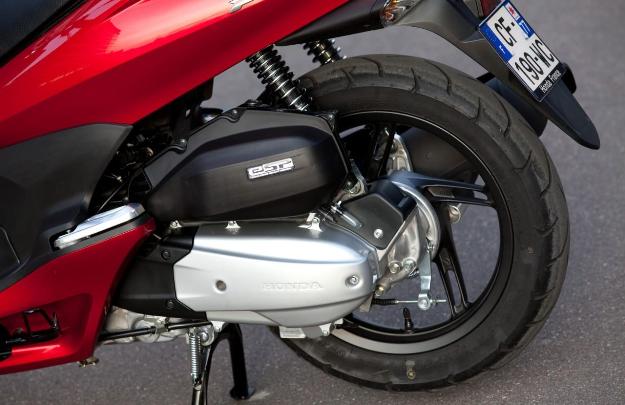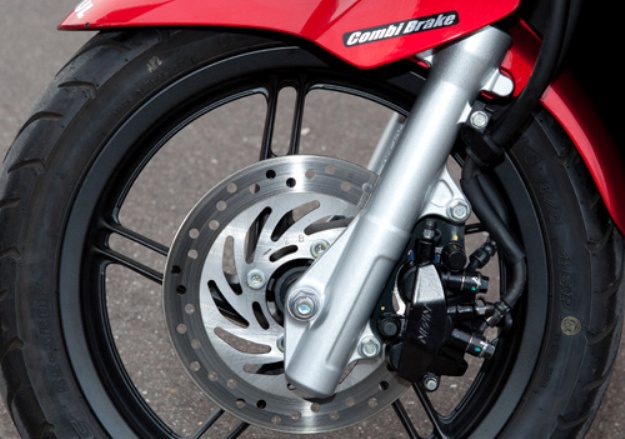European bestseller, Honda PCX 125 returns to us equipped with a new motorization called ESP. The block always integrates technology “stop and start” but its new output would make it still more economic and more reliable. After test, bikescatalog reveals you the secretaries of them!
Appreciated for his quality positive ratio/price, its contemporary look and its many practical aspects, Honda PCX 125 knows one big hit since its launching in spring 2010. This year 2012 of course preserves the intrinsic assets of its predecessors, starting with a modern line and appreciably more affluent than that of its principal rivals (Peugeot Vivacity, Piaggio Fly and consorts…). Nothing betrays truly the manufacturing inhabitant of Thailand of the PCX, which profits from a good quality of manufacturing and a beautiful quality of completion.
The level of equipment is contained, but the Honda PCX 125 has a true trunk under saddle, able to accommodate a crash helmet, like some personal effects. The opening of saddle is carried out since an order placed close to the contactor, which also opens the trap door of the petrol tank placed on the central pontoon. The lock has a system of screening making it possible to minimize the risks of break and of course blocks the use of the system of opening of saddle and traps when the direction is secure. Thought well!
Honda PCX 125: complete equipment
Small a no bolt able vacuum-pocket is arranged in the left part of the apron, while a small carry-package integrating the handles of momentary maintenance allows the addition of a top-box optional of 26 liters. Note that the passenger has practical retractable footrests, the driver profiting for its part from long foot boards.
The instrumentation of edge is brief, with a simple analogical tachometer, a small digital dial (gauge of level of petrol with segments and kilo metric totalizes), like various indicators and luminous witnesses (system idling stop, injection, headlight, indicators and temperature of water).
Malignant townsman
Low of saddle (760 mm), the Honda PCX 125 is caught easily in hand in spite of the fact that it is necessary to span the central pontoon or the saddle to take seat on board.
The driver finds its brands instantaneously, with a handlebar placed lower, the feet well flat with the stop, an ergonomic and comfortable base, as well as long foot boards, which enable him to lengthen its legs when it wishes more relaxed control. Camped well on its large wheels of 14 inches, the Honda PCX 125 shows a good stability online and is registered naturally in curves, without reserve or excessive promptness.
Its short turning radius confers an exceptional handiness to him, which largely facilitates the operations of release in the obstructions townsmen. A genuine bicycle, all the more pleasant and easy to take along that one benefits from a view from above and released well on the road.
In this urban context, new engine eSP (enhanced Smart Power) would confer on the PCX a promptness and appreciably increased performances (profit of 0.37 CH and 0.48 Nm of couple to the same modes). Nothing truly perceptible as compared to the previous model, but it is preferable to evolve in this direction that in the other.
Starting of the Honda PCX 125 thus remains relatively sharp, even in mode “idling stop” (disengage able) driving decree, with an instantaneous alarm clock of the engine to least acceleration and a rise in fast mode on the first meters, linear then. The approval of use remains excellent, the PCX answered promptly the least request of the accelerator and ensured of good revivals since the intermediate modes.
Pleasant and effective in this urban context, this new engine eSP especially profits from many improvements intended to increase its longevity while reducing its polluting emissions and its petrol consumption.
This one indeed passes from 2.17 l/100 km on the PCX 2010 to 2.10 l/100 km for this model 2012 to engine eSP (standardized measurements WMTC, system idling active stop). Improvements obtained thanks to the reduction of internal frictions and transmission, like by the optimization of the cooling system.
Not ridiculous on road
Less at ease on fast tracks downtown, the Honda PCX 125 is freed all the same without sorrow from the urban limits with a top speed from 102 km/h stopwatch (108 km/h meter). A modest pace on fast tracks limited to 110 km/h, but nevertheless sufficient to apprehend the interurban ways without too much stress.
On road, the jump-wind short proposed of origin is not enough to effectively protect the driver from the elements, in particular in rainy weather. The more so as the relative width of the central pontoon Prevented from protecting its legacy well behind the narrow apron Rather, Itself. A more protective optional windshield is fortunately proposed as an option, as well as many other specific accessories.
The dynamic behavior of the Honda PCX 125 remains quite as correct in this road context, with a stability online convincing with high-speed and a sufficiently rigorous frame in the sequences of turns negotiated with sharp pace. Appreciable as regards comfort, to moderate pace, the relative flexibility of the suspensions comes however quickly refrained the heat from the most hardened pilots of “sporting” use.
The back compound shock absorber indeed reacts more curtly on the way of a constraint boxed on the angle, thus disturbing the precision of course hitherto excellent. Phenomenon obviously accentuated when a little heavy passenger is transported.
Perfectly Combined braking functions, but one should not hesitate to use the two levers in the event of emergency braking for a greater effectiveness. Pneumatic tires IRC of origin offer their part a satisfactory grip on dry road but encourage with more prudence in rainy weather.
In regard with the petrol consumption, Honda PCX 125 eSP gratified us as one of 3.32 average l/100 km on our mixed way (city/road/fast tracks) of 132 kilometers. It thus offers an average autonomy of 178 km with the 5.9 liters of patrols contained in its tank.
Assessment: An economic, but not sold off scooter
Sold 2490 €, Honda PCX 125 year 2013 (same characteristics as the PCX 2012, with 4 new colors) remains appreciably more expensive than many of its rivals, closer to 2000 €. A differential of price which is justified partly by a more affluent gauge and some proven practical aspects (better longevity, weak emissions of CO2, large trunk and combined braking, in particular).
For as much, everyone does not have ecological fiber and some complementary equipment would have helped with better justifying this differential of price like, for example, a more protective windshield of origin or a simple digital clock with the instrument panel.
Honda PCX 125 eSP 2012 – 2013: To retain
Practice:
Price: 2,490 €
Color: white, money, red, blue
Warranty: 2 years, parts and labour
Availability: immediate
Engine
The Honda PCX 125 year 2012 has new engine eSP, equipped with last anti friction technologies of the Japanese constructor. This engine receives in particular an eccentric cylinder limiting the frictions generated by the contact between the piston and the walls of the cylinder. The weight of the piston was lowered and for this thanks to the recourse to the CAO (computer assisted design).
The shirt is characterized by the presence of pins on its external surface in order to support cooling and to limit the oil consumption. A needle bearing is used on the axis of the rocking-levers with rollers, taking part in the reduction of frictions. The rollers, compact and light, act on cams with the optimized profiles whereas the stiffness within the competences of valves was given with precision.
The radiator is 1.5 times more effective, making it possible to resort a smaller and lighter ventilator, reducing frictions of 30 %. Internal modifications lower the losses by splashing, involving a reduction in the oil capacity of transmission by 25 %. The losses by frictions in the transmission were reduced by 20 % (to 50 km/h), in particular thanks to the use of bearings specifically adapted to the load which they must ensure.
Like its predecessor, this engine integrates technology “idling-Stop”, which automatically stops the engine at the time of a stop and starts again it instantaneously with the restarting. This disengage able system is activated by an order located at the right handle.
The engine is cut after 3 seconds spent to the idle and sets out again with the least request of the accelerator. The smoothness of operation is ensured by a mechanism which repositions the crankshaft in the optimal position before the phase of admission and by a mechanism of relief cock which cancels the compressive strength during this adjustment.
Thus equipped, the Honda PCX 125 announces a consumption of 2.1 l/100 km and autonomy of 280 km (mode of test WMTC). A new driving belt, quieter and resistant, also takes part in the reduction of consumption.
Part cycles
The Honda PCX 125 has a framework of the open type out of steel tubes. It displays a relatively compact gauge, with a footing of 1305 mm. Its turning radius limited to 1.98 m facilitates the operations. The suspension is ensured by a telescopic fork the tubes 31 mms in diameter (discussing on 100 mm) and a back compound shock absorber (adjustable in reload of the spring) discussing on 75 mm.
Braking is of combined type (with the left lever), with a disc before 220 mm with clamp 3 pistons associated with a back drum 130 mms in diameter. The wheels of 14 inches have alloy rims with 5 fitted branches of pneumatic tires of brand IRC.
Equipment manufacturing
Manufactured in Thailand, Honda PCX 125 profits from a good quality manufacturing and a good level from completions, with well painted and perfectly assembled plastics. It has a trunk under saddle making it possible to arrange a crash helmet besides some personal effects, whose opening is ordered since a button located close to the contractor Neiman. The carry-package integrating the handles of momentary maintenance is designed to accommodate a top-box optional of 26 liters.
The passenger has retractable footrests and the driver of a lumbar support integrated into the saddle. The instrumentation of edge is brief, with a broad analogical tachometer, some luminous indicators and witnesses, as well as a digital dial gathering gauge of level of petrol with segments and kilo metric tantalizers. The Honda PCX 125 also has small limps with gloves, of two crutches and a tinted jump-wind.



